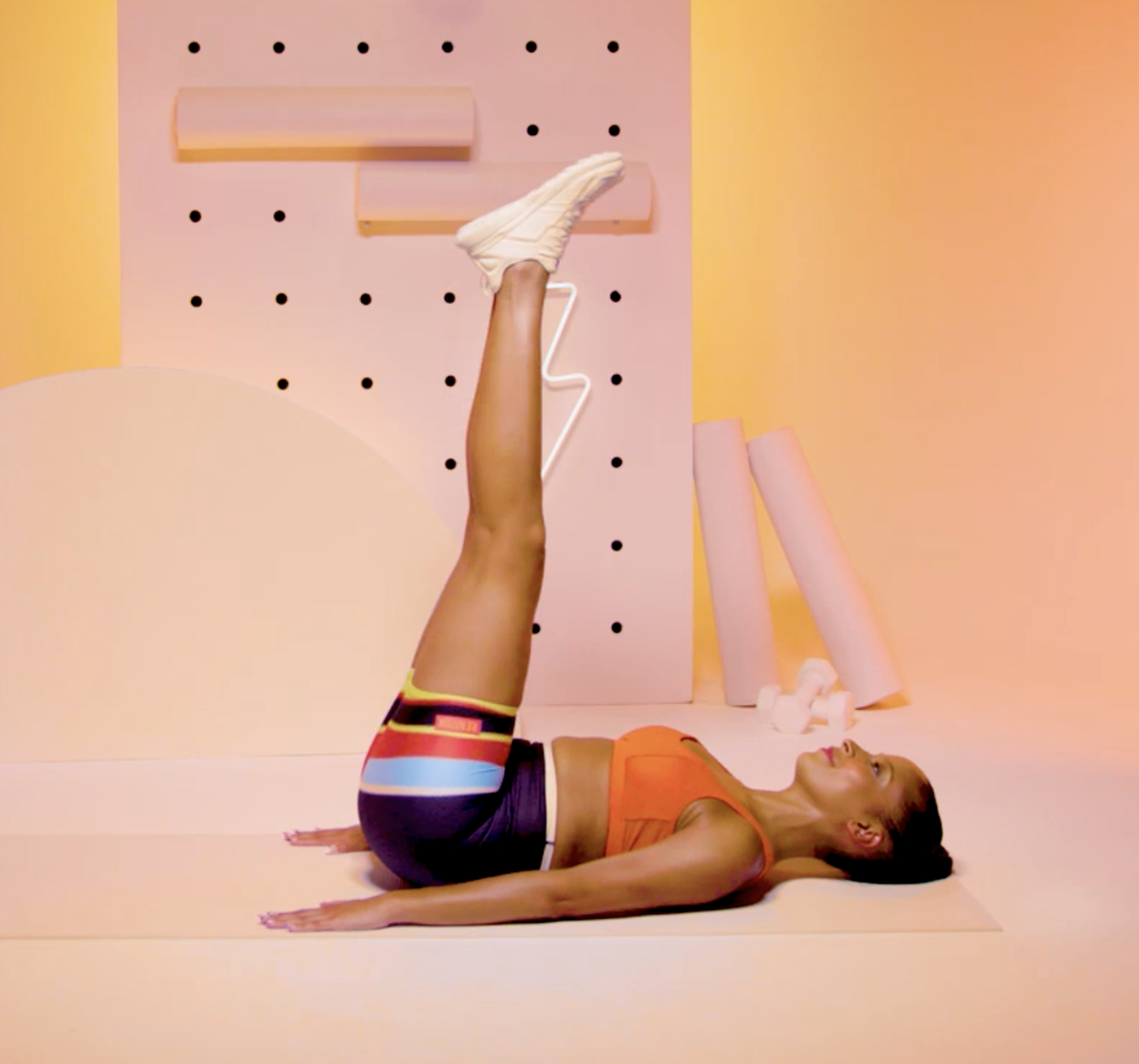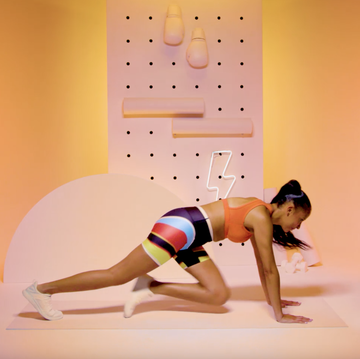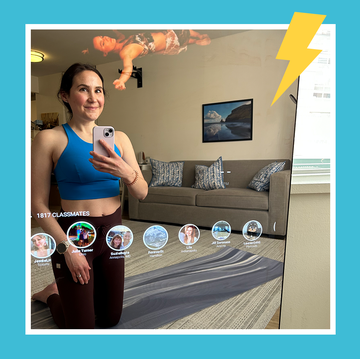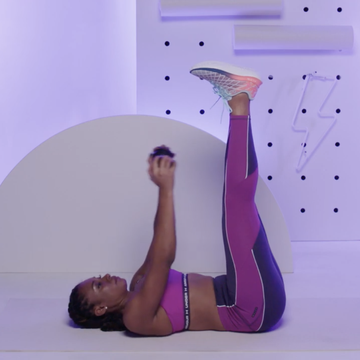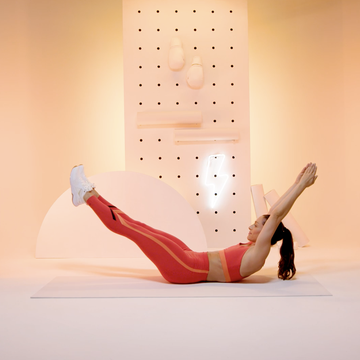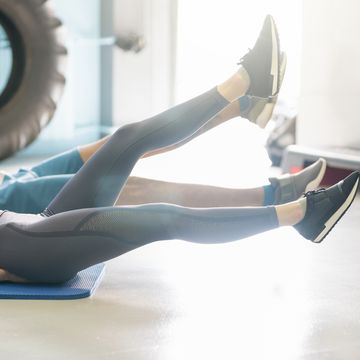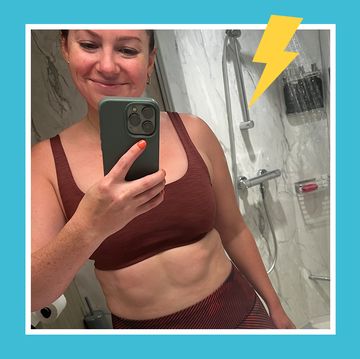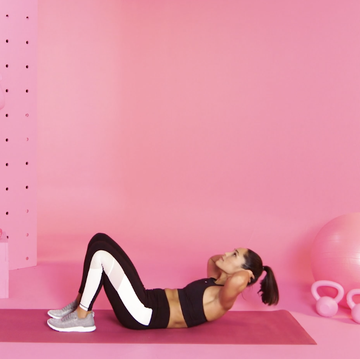I've been there done that with the classic core burners like planks, crunches, and sit-ups. I'm ready for a refresh. To achieve stronger, more sculpted abs, any trainer will tell you that it’s all about variety.
Upping core strength in this way comes with plenty of perks. “Your core is where everything originates, and you want to think of the core as your body’s central foundation,” says Ellen Thompson, CPT, the head personal trainer at Blink Fitness. “If your core is strong, stable, and agile, the rest of your body has the ability to achieve numerous and varied fitness goals.”
Meet the experts: Melissa Kendter, CPT, is an ACE-certified personal trainer and EvolveYou trainer. Ellen Thompson, CPT, is a NASM-certified personal trainer and the head personal trainer at Blink Fitness. Michael Hamlin, CSCS, is a certified strength and conditioning specialist and the founder of Everflex Fitness.
More From Women's Health

Core strength also allows you to move more efficiently and increase your power and speed to help you maintain proper form during endurance sports, says Melissa Kendter, CPT, EvolveYou trainer. "When you solidify and strengthen your trunk, everything else feels easier." Here. For. It.
What is the core?
Your core technically includes your entire trunk, the abdominals, obliques, pelvic floor, lower back, hips, diaphragm, and glutes, says Thompson. “Your core is the central part of your body, and is layers of deep muscles that help support your pelvis, spine, butt, back, hips, and stomach,” says Kendter. “They are foundational muscles for keeping our posture strong and tall, while allowing us to stabilize and move properly through all movements."
Now that you know what muscles you're targeting, prepare to switch up your core workout and switch on all your abdominals.
20 Best Core Exercises For Strong Abs
Time: 15 minutes | Equipment: Mat, dumbbells, stability ball | Good for: Core
Instructions: Choose one exercise from each group below, for a full core workout programmed by certified personal trainers.
A: Deadbug bodyweight, kettlebell bridge pullover, kettlebell deadbug pullover, single-arm floor press deadbug, glute bridge march
B: Side plank, stability ball rollout, inchworm, bird dog, bear crawl, stability ball stir the pot
C: Unilateral dumbbell march, kettlebell goblet squat, Russian twist, incline mountain climbers, leg lowers, Turkish get-up, squat to oblique twist.
Complete three sets of the indicated number of reps for each move. Once you've completed all sets of one move, continue to the next, in ABC order. Alternatively, incorporate these core exercises into a full-body routine.
1. Single-Arm Press
Why it rocks: “This move has greater demands on balance and stability because your core and body have to resist the urge to rotate when you use one arm to press,” says Kendter. As a result, this causes greater activation of the core and obliques, she explains.
How to:
- Stand with feet hip-width apart and hold a dumbbell in your left hand.
- Extend your right arm out to your side at a 45-degree angle from your body while you rack the dumbbell on right shoulder. This is your starting position.
- Brace your core and begin to raise the weight overhead, keeping your bicep close to your ear and palm facing toward you.
- Return to start. That's 1 rep. Continue for 10 reps on each side.
2. Deadbug
Why it rocks: “Deadbugs are good for just about any skill level because they are a safe and effective way to strengthen and stabilize your core, spine, and back muscles,” says Kendter. “They target the same stabilization muscles as a plank, but without posing as much potential strain to the low back.”
How to:
- Lie on your back with your arms extended over your chest and legs bent 90 degrees (knees above hips).
- Keep your low back pressed to the floor, brace your core, then slowly and simultaneously extend and lower your right leg until your heel nearly touches floor and your left arm until your hand nearly touches floor overhead.
- Pause, then return to start and repeat with the opposite leg and arm. That’s 1 rep. Complete 10 reps.
3. Glute Bridge March
Why it rocks: “The glute bridge march works the core and glutes, improving stability and strength in the pelvic and hips,” explains Kendter. “The glute bridge and all its forms are great at strengthening the gluteal muscles which will make you stronger.”
How to:
- Lie on your back with your legs bent, heels under knees, feet flat on the floor.
- Extend your arms over your chest, palms facing. Raise your hips so your body forms a straight line from your shoulders to your knees.
- Brace your abs and lift your right knee over your hip, maintaining the 90-degree angle of that leg.
- Hold for a moment, then lower your right foot. Repeat with the left. That's 1 rep. Complete 12 reps.
4. Side Plank
Why it rocks: Looking for a killer core move that can be done anytime and any place? Say hello to side planks. “They work the deep spinal stabilizing muscles to strengthen your core, particularly your obliques, without stressing your back,” says Kendter.
How to:
- Lay on your side with your right forearm flat on the floor, elbow under your shoulder, and both legs extended, forming a straight line from your head to your feet. (Feet can either be staggered for more stability, or stacked for more of a challenge.)
- Engage your core and lift your hips off the floor. Hold for 30 seconds on each side.
5. Inchworm
Why it rocks: “This is a full-body bodyweight movement that increases strength and flexibility within the arms, upper back, core, and legs,” says Kendter. “You have to engage your core to bend over and walk out into a high plank position and back, so you get a lot of bang for your buck.”
How to:
- Stand with your feet hip-width apart. Slowly bend over and touch the floor in front of your feet with both hands.
- Keeping your legs as straight as possible and core tight, walk your hands forward, without letting your hips drop, until you reach a high plank position.
- Pause, then slowly walk your feet toward your hands. That's 1 rep. Complete 10 reps.
6. Bird Dog
Why it rocks: “The bird dog, like the deadbug, is a simple core exercise that improves stability and encourages a neutral spine,” explains Kendter. Plus, this movement uses the whole body to target and strengthen your core, hips, and back muscles, while helping to promote proper posture which can help relieve lower back pain, she adds.
How to:
- Get on all fours with your wrists stacked directly under your shoulders and knees under hips.
- Keeping your back flat, core engaged, and a slight bend in your elbows, extend your left arm out in front of you at shoulder height and your right leg straight behind you at hip height.
- With control, bring your extended leg back underneath you, stopping at your hips, and tap that knee with your opposite hand.
- Lower your leg and arm down, then repeat on the opposite side. That's 1 rep. Complete 10 reps.
7. Bear Crawl
Why it rocks: “Since you're moving on all fours hovering over the ground as you perform this exercise, your core muscles really have to fire to keep your spine, hips, and shoulders stabilized,” says Kendter. The bear crawl is also a great warm up exercise or finisher since it lights up your entire body, she adds.
How to:
- Start in tabletop position at the back of your mat with your wrists under your shoulders, knees under hips, and your neck aligned with your spine.
- Keep a slight bend in your elbows. Raise your hips slightly to lift your knees off the floor while maintaining a flat back.
- Slowly walk your hands and feet forward to the top of your mat, then reverse the movement. That's 1 rep. Complete 12 reps.
8. Single-Arm Floor Press Deadbug
Why it rocks: This move has greater demands on your balance and stability since your core and body have to resist the urge to rotate when you singular arm press, which causes greater activation of the core, explains Kendter.
How to:
- Lie on your back with your legs bent (knees over hips) and arms extended at chest height, holding a dumbbell in your left hand, palm facing away from you.
- Press your low back to the mat and brace your core. That's your starting position.
- Slowly and simultaneously extend and lower your right leg until your heel nearly touches floor as you bend your left arm until it touches the floor at a 45-degree angle from your body.
- Pause, then return to start. That’s 1 rep. Complete 10 reps on each side.
9. Kettlebell Bridge Pullover
Why it rocks: “This exercise increases the strength of the anterior core and glutes, and due to its eccentric nature, it provides a lot of time under tension,” explains Kendter. It also teaches your hamstrings, glutes, and abs to work together, she adds.
How to:
- Lie on your back with your knees bent and your feet flat on the floor. Hold a kettlebell in both hands, resting on top of your chest.
- Raise your hips so your body forms a straight line from your shoulders to your knees.
- Lift the kettlebell into the air over your chest, then slowly lower it behind you until it nearly touches the ground without arching your back or splaying your rib cage.
- Engage your core and return the kettlebell over your chest. That's 1 rep. Complete eight reps.
10. Kettlebell Deadbug Pullover
Why it rocks: When you’re ready for a progression from the traditional dead bug, the kettlebell deadbug pullover adds an additional load, says Kendter. “It strengthens the abdominal muscles and helps promote neutral spine and anti-rotation.”
How to:
- Lie on your back with your legs bent at 90 degrees (knees over hips) and arms extended over your chest holding a kettlebell with both hands. That's your start position.
- Press low back in to floor, brace your core, then slowly and simultaneously extend and lower your right leg until your heel nearly touches floor while you lower the kettlebell overhead until it nearly touches the floor behind you.
- Pause, then return to start and repeat on the opposite side. That’s 1 rep. Complete eight reps.
11. Stability Ball Deadbug
Why it rocks: Adding a stability ball to your deadbug can boost your spinal and core stability while simultaneously engaging your abdominals, explains Kendter. Trust us, it’s tougher than it looks.
How to:
- Lie on your back with your legs bent at 90 degrees and arms extended over your chest holding a stability ball between your forearms and knees.
- Press low back in to the mat, brace your core, then slowly and simultaneously extend and lower your right leg until your heel nearly touches floor and your left arm overhead until your hand nearly touches floor behind you.
- Pause, then return both knee and forearm to the stability ball and repeat on the opposite side. That’s 1 rep. Complete 10 reps.
12. Stability Ball Stir The Pot
Why it rocks: Looking for an advanced core move? Try this out because “stirring the pot” on a stability ball works the core muscles by challenging the stability of your abdominals while you balance your forearms in a plank position and rotate, Kendter explains.
How to:
- Place your forearms on a stability ball and extend your legs directly behind you into a high plank—your body should form a straight line from head to heels.
- Brace your abs and move your forearms in a full circle, so the stability ball moves as well, keeping the rest of your body still. That's 1 rep. Do 10 reps then reverse the circle for 10 reps.
13. Stability Ball Rollout
Why it rocks: “This is an advanced exercise which is an overall bang for your buck,” says Kendter. “I love this advanced plank variation since it adds the element of instability because of the ball, which means more muscles are engaged overall.” And, thanks to the “rollout” portion of the movement, it’s going to increase the intensity even more.
How to:
- Start by kneeling on your mat and place your forearms on a stability ball.
- Slowly move your arms forward, until your body forms a straight line. Hold here for three seconds, then roll back until your hips are over your knees. That's 1 rep. Complete as many reps as you can in 30 seconds.
14. Unilateral Dumbbell March
Why it rocks: Unilateral dumbbell marches are one of Kendter’s favorite moves for a reason. Not only do they train your core stability by adding an offset weight to the center body, but they also offer work on your grip strength, upper body development, and overall athleticism, she notes.
How to:
- Stand up straight, with your feet shoulder-width apart.
- Hold a dumbbell in your left hand and extend your right arm out to your side at a 45-degree angle from your body.
- Slowly lift your left leg up until your knee is at hip height.
- Then, with control, lower your leg down to the ground. Repeat on the other side. That's 1 rep. Complete 10 reps, switch hands with the dumbbell, and do another 10 reps.
15. Kettlebell Goblet Squat
Why it rocks: “This exercise is a must for your core because it not only works your lower body, but the weight in front of your chest forces your core to work harder in order to maintain stability and balance,” says Michael Hamlin, CSCS, a certified strength and conditioning specialist and the founder of Everflex Fitness.
How to:
- Hold a kettlebell and stand with your feet slightly wider than hips-width apart and toes pointed slightly out.
- Pin your elbows to your rib cage and hold the weight right under your chin and grip the kettlebell by the horn, right-side-up.
- Engage your core and keep your arms close to your chest and elbows pointing down as you bend your hips and knees and squat down as low as you can without letting your lower back round at the bottom.
- Pause for two seconds, then drive through your glutes, legs, and heels to stand back up to the starting position. That's 1 rep. Complete 10 reps.
16. Russian Twist
Why it rocks: “Russian twists rock your core because it targets your obliques which are often neglected in traditional ab exercises, as well as your rectus abdominis or the muscles we typically associate with a six-pack,” says Hamlin.
How to:
- Sit on the ground with your knees bent and your feet flat on the floor.
- Lean back slightly and lift your feet off the ground a few inches, balancing on your sit bones.
- Hold a weight in front of your chest and rotate your torso to one side, tapping the weight on the ground next to your hip before twisting to the other side. That’s 1 rep. Complete 12 reps on each side.
17. Incline Mountain Climbers
Why it rocks: “This exercise is great for your core because it engages your abs and obliques to stabilize your torso as you move your legs,” says Hamlin. Plus, if you don't have access to a bench or chair, Hamlin says you can do this move against a wall which will bring some extra fire to your abs and hips.
How to:
- Start in a high plank position with your hands on a bench, step, chair, or wall.
- Bring one knee up toward your chest, then slowly bring your leg back down, focusing on control and keeping your tailbone stable at the top of the movement.
- Repeat on the opposite leg while keeping your core engaged the entire time. That’s 1 rep. Complete 12 reps on each side.
18. Leg Lowers
Why it rocks: “This movement is great for your core because it targets your rectus abdominus (six-pack) and your hips,” says Hamlin. “Additionally, this exercise can help improve your hip flexibility, as you work to maintain a straight leg position while lowering and lifting each leg.”
How to:
- Lie on your back with your legs extended and your arms at your sides.
- Lift both legs straight up toward the ceiling.
- Slowly lower both legs toward the floor while engaging your lower abs and keeping your lower back flat to the floor. (Option to modify and alternate lowering one leg at a time.)
- Return your legs back up to the starting position. That’s 1 rep. Complete 12 reps on each side.
19. Turkish Get-up
Why it rocks: “Turkish get-ups are super challenging for your entire body and require core stability and control throughout the entire movement,” says Hamlin. Not to mention, this move is also great for improving stability and strength in your upper and lower body, he adds.
How to:
- Lie on your back with a kettlebell in your right hand resting in front of your shoulder. Bend your right leg, placing your foot flat on the floor. Stretch out your left arm and leg to the side at a 45-degree angle.
- Get a good grip on the handle and press the weight up toward the ceiling, locking out the elbow completely and keeping a gaze on the kettlebell.
- With eyes still on the bell overhead, rise onto the left forearm, then push into the palm of the left hand to sit up.
- Engage abs, then push through the right heel and squeeze glutes to lift hips until the right thigh is parallel to the floor.
- In one fluid motion, raise the torso and slide your left leg behind your body, toes angled toward the back-right corner behind you.
- Swivel your left shin to the left so that the foot is directly behind the body and raise the torso to come into a half-kneeling lunge.
- Keeping your core tight, drive into the right heel to stand, with your feet hip-width apart. Slowly and with control, reverse the move back to the starting position. That’s 1 rep. Do 3 to 5 reps on each side.
20. Squat To Oblique Twist
Why it rocks: “This exercise is amazing for your core because it works multiple muscle groups, including your glutes, quads, and core muscles,” says Hamlin. “The squat targets your lower body, while the knee drive engages your hip flexors and obliques, helping to improve your balance and stability,” he explains. From there, the twisting motion challenges your core muscles and obliques to work together, helping to improve your overall core strength.
How to:
- Stand with your feet shoulder-width apart and your hands lightly touching the back of your ears.
- Lower your body into a squat position while focusing on keeping your chest upright and weight balanced between your toes and heels.
- Push through your feet to stand back up, and drive one knee up and across your chest, twisting your torso and bringing your opposite elbow to that knee.
- Bring your knee back down and return to the starting position. That’s 1 rep. Do 12 reps on each side.
Emily Shiffer is a freelance health and wellness writer living in Pennsylvania.
Andi Breitowich is a Chicago-based writer and graduate student at Northwestern Medill. She’s a mass consumer of social media and cares about women’s rights, holistic wellness, and non-stigmatizing reproductive care. As a former collegiate pole vaulter, she has a love for all things fitness and is currently obsessed with Peloton Tread workouts and hot yoga.
